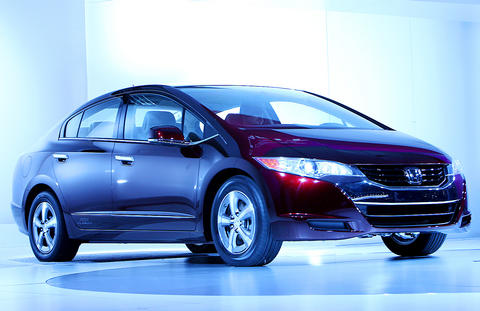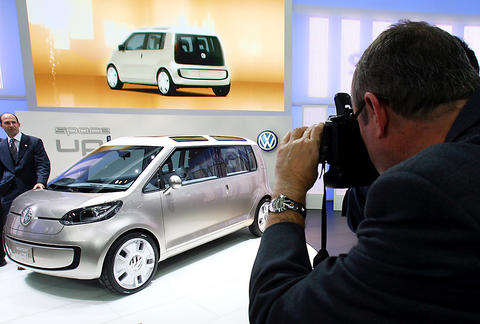When a family sedan that can barely reach 120km per hour gets more attention than the unveiling of a US$1.4 million Lamborghini, you know something major is happening in the auto world.
That was the scene Friday at the Los Angeles Auto show, where thousands flocked to see new hydrogen fuel-cell models from carmakers Honda and General Motors with more enthusiasm than the extraterrestrial Italian supercar the Lamborghini Reventon.
"The Los Angeles show illustrates how automakers, in general, now value miles per gallon as much as miles per hour," said Rick Popely, an auto writer from Chicago.

PHOTO: AFP
Headlining the LA show were announcements from Honda and General Motors as each unveiled plans to market the first hydrogen fuel-cell vehicles early next year. But don't look for them in your local showroom just yet.
Honda said it will begin leasing its new FCX Clarity, powered by a hydrogen fuel cell, to drivers in summer 2008 in southern California.
Honda would not say how many vehicles will be available in the limited lease program. The company plans to offer a three-year lease with a US$600 monthly payment on the sleek, aerodynamic FCX Clarity sedan. Using a fuel cell that combines hydrogen with oxygen to produce electricity from the chemical reaction, the vehicle will have fuel economy of 30km per liter, and the only emissions will be water dripping from the tail pipe.

PHOTO: AFP
US automaker General Motors said it will put 100 fuel-cell vehicles on the road starting next year in California, New York and the city of Washington, including 10 that will transport visitors at Disneyland.
The fuel-cell powered Chevrolet Equinox, a compact sport-utility vehicle (SUV), is the first in a line of hydrogen vehicles that GM says it expects to see in showrooms by 2012, when it plans to start producing 1 million hydrogen vehicles a year.
GM unveiled a hybrid version of its heavy-duty Silverado pickup truck and earned a Green Car of the Year Award for its Chevy Tahoe hybrid, which boasts a two-mode gasoline-electric engine developed with BMW, Mercedes and Chrysler that improves the massive vehicle's fuel economy by 50 percent from conventional models.
Chrysler unveiled its own large hybrids, a Dodge Durango and a Chrysler Aspen. Ford unveiled hybrid plans, as did Porsche, Volkswagen and Audi.
The excitement belied the so-far niche interest of buyers in hybrid vehicles, which currently account for just 2 percent of car sales in the US. But a ruling this week by a federal appellate court in California required the Bush administration to significantly tighten fuel-economy standards.
The court's order overruled previous regulations that failed to thoroughly assess the economic impact of tailpipe emissions that contribute to climate change.
The ruling came in response to an appeal by four environmental groups and 13 states led by California against loopholes in the federal government's fuel-economy requirements for automakers. California is suing the federal government to get permission to enforce its own fuel-economy standards.
California Governor Arnold Schwarzenegger described the ruling as "another win for the environment and for consumers."
"Clearly, automobile companies have the capability to produce environmentally friendly cars," he said. "Today's court ruling underscores the need for the federal government to step in and provide the extra push necessary to make these vehicles widespread."

Exceptions to the rule are sometimes revealing. For a brief few years, there was an emerging ideological split between the Democratic Progressive Party (DPP) and Chinese Nationalist Party (KMT) that appeared to be pushing the DPP in a direction that would be considered more liberal, and the KMT more conservative. In the previous column, “The KMT-DPP’s bureaucrat-led developmental state” (Dec. 11, page 12), we examined how Taiwan’s democratic system developed, and how both the two main parties largely accepted a similar consensus on how Taiwan should be run domestically and did not split along the left-right lines more familiar in

This month the government ordered a one-year block of Xiaohongshu (小紅書) or Rednote, a Chinese social media platform with more than 3 million users in Taiwan. The government pointed to widespread fraud activity on the platform, along with cybersecurity failures. Officials said that they had reached out to the company and asked it to change. However, they received no response. The pro-China parties, the Chinese Nationalist Party (KMT) and Taiwan People’s Party (TPP), immediately swung into action, denouncing the ban as an attack on free speech. This “free speech” claim was then echoed by the People’s Republic of China (PRC),

As I finally slid into the warm embrace of the hot, clifftop pool, it was a serene moment of reflection. The sound of the river reflected off the cave walls, the white of our camping lights reflected off the dark, shimmering surface of the water, and I reflected on how fortunate I was to be here. After all, the beautiful walk through narrow canyons that had brought us here had been inaccessible for five years — and will be again soon. The day had started at the Huisun Forest Area (惠蓀林場), at the end of Nantou County Route 80, north and east

Specialty sandwiches loaded with the contents of an entire charcuterie board, overflowing with sauces, creams and all manner of creative add-ons, is perhaps one of the biggest global food trends of this year. From London to New York, lines form down the block for mortadella, burrata, pistachio and more stuffed between slices of fresh sourdough, rye or focaccia. To try the trend in Taipei, Munchies Mafia is for sure the spot — could this be the best sandwich in town? Carlos from Spain and Sergio from Mexico opened this spot just seven months ago. The two met working in the